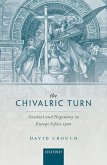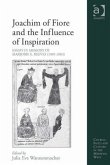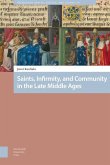Clelia V. Crialesi
Mathematics and Philosophy at the Turn of the First Millennium
Abbo of Fleury on Calculus
Clelia V. Crialesi
Mathematics and Philosophy at the Turn of the First Millennium
Abbo of Fleury on Calculus
- Gebundenes Buch
- Merkliste
- Auf die Merkliste
- Bewerten Bewerten
- Teilen
- Produkt teilen
- Produkterinnerung
- Produkterinnerung
Mathematics and Philosophy at the Turn of the First Millennium sheds light on Abbo's original philosophical system anchored in two central doctrines, which serve as a compass to navigate it: the theory of oneness (henology) and the theory of composition.
Andere Kunden interessierten sich auch für
![Chivalric Turn Chivalric Turn]() David CrouchChivalric Turn133,99 €
David CrouchChivalric Turn133,99 €![Animals and Hunters in the Late Middle Ages Animals and Hunters in the Late Middle Ages]() Hannele KlemettiläAnimals and Hunters in the Late Middle Ages190,99 €
Hannele KlemettiläAnimals and Hunters in the Late Middle Ages190,99 €![Joachim of Fiore and the Influence of Inspiration Joachim of Fiore and the Influence of Inspiration]() Joachim of Fiore and the Influence of Inspiration168,99 €
Joachim of Fiore and the Influence of Inspiration168,99 €![China and Africa in the Middle Ages China and Africa in the Middle Ages]() Teobaldo FilesiChina and Africa in the Middle Ages40,99 €
Teobaldo FilesiChina and Africa in the Middle Ages40,99 €![European Women's Letter-writing from the 11th to the 20th Centuries European Women's Letter-writing from the 11th to the 20th Centuries]() Clare MonagleEuropean Women's Letter-writing from the 11th to the 20th Centuries151,99 €
Clare MonagleEuropean Women's Letter-writing from the 11th to the 20th Centuries151,99 €![Saints, Infirmity, and Community in the Late Middle Ages Saints, Infirmity, and Community in the Late Middle Ages]() Jenni KuulialaSaints, Infirmity, and Community in the Late Middle Ages132,99 €
Jenni KuulialaSaints, Infirmity, and Community in the Late Middle Ages132,99 €![Lordship and Feudalism in the Middle Ages Lordship and Feudalism in the Middle Ages]() Guy FourquinLordship and Feudalism in the Middle Ages91,99 €
Guy FourquinLordship and Feudalism in the Middle Ages91,99 €-
-
-
Mathematics and Philosophy at the Turn of the First Millennium sheds light on Abbo's original philosophical system anchored in two central doctrines, which serve as a compass to navigate it: the theory of oneness (henology) and the theory of composition.
Produktdetails
- Produktdetails
- Verlag: Routledge
- Seitenzahl: 222
- Erscheinungstermin: 31. März 2025
- Englisch
- Abmessung: 240mm x 161mm x 17mm
- Gewicht: 502g
- ISBN-13: 9781032643458
- ISBN-10: 1032643455
- Artikelnr.: 72106032
- Herstellerkennzeichnung
- Libri GmbH
- Europaallee 1
- 36244 Bad Hersfeld
- gpsr@libri.de
- Verlag: Routledge
- Seitenzahl: 222
- Erscheinungstermin: 31. März 2025
- Englisch
- Abmessung: 240mm x 161mm x 17mm
- Gewicht: 502g
- ISBN-13: 9781032643458
- ISBN-10: 1032643455
- Artikelnr.: 72106032
- Herstellerkennzeichnung
- Libri GmbH
- Europaallee 1
- 36244 Bad Hersfeld
- gpsr@libri.de
Clelia V. Crialesi is a Marie Sk¿odowska-Curie Fellow at SPHERE-CNRS (France). Formerly, she was an FWO Research Fellow at KU Leuven (Belgium) and a Mellon Fellow at PIMS (Canada). Her research focuses on premodern mathematical thought, with publications ranging from Boethian number theory to Euclidean geometry in the late medieval continuum debate.
Introduction
Chapter 1
Abbo and His Time: European History and Mathematics
1. Politics and (Religious) Culture
2. Liberal Arts
3. Mathematics
3.1 Speculative Arithmetic
3.2 Practical Arithmetic
Chapter 2
Victorious' Calculus and Abbo's Explanatio
1. Contents of the Calculus
1.1 Praefatio de ratione calculi
1.2 Multiplication Tables
1.3 Supplementary Tables and Texts
2. Victorious, scripulorum calculator: the Calculus and the Reckoning of
Time
3. Two Hypothesis on the Arrival of the Calculus at Fleury
3.1 Hypothesis A: Lupus of Ferrière
3.2 Hypothesis B: Columbanus and the Abbey of Bobbio
4. Abbo's Explanatio: Manuscripts and Critical Editions
5. Contents of the Explanatio
5.1 The Prologue (Section I)
5.2 The Theological Premise (Section II)
5.3 The Commentary on on Victorius's Praefatio (Section III)
5.4 The Commentary on Victoriuous's Multiplication Tables (Section IV)
5.5 On Qualitative Physics (Section V)
6. The Pedagogical Aim and the Role of the Commentator
Chapter 3
A Theological Premise: Number, Measure, and Weight
1. Augustine and Wisd. 11:21
2. Claudianus Mamertus' De statu animae
3. Arithmetical Readings of Wisd. 11: 21: Hrabanus Maurus and John Scotus
Eriugena
4. Abbo's Tractatus de numero, mensura et pondere
Chapter 4
Henology
1. Neopythagorean Elements: Unity and the Flow of Numbers
2. The Highest Good, individuum, and Unity
3. The Lambda Diagram: a Quadrivial Henology
4. Unity as Ontological Principle
5. Unity as the Object of Arithmetic and Calculus
Chapter 5
The Composition of Reality
1. Natural Compounds
1.1 The Arithmology of Natural Compounds
1.2 Natural Compounds and Change: the Phases of the Moon
2. Artificial Compounds
2.1 The Five Kinds of Inequality Ratios
2.2 Two trinae regulae for Arithmetical Ratios
3. Ontological Composition: the Case of the Earth in Gen. 1:2
4. Division of Non-Material Entities: the Case of the Units of Time
5. Divisibility and Corporality: the Case of the vox
Chapter 6
Arithmetic and Calculus
1. Fractions: Ounces and minutiae
2. Representing Integer Numbers
3. Calculus by Fingers or the loquela digitorum
4. Calculus by Tables
5. Multiplication Rules
Chapter 7
Physics Before the Physics
1. The Early Medieval Concern for Natural Phaenomena
2. Scientific Literature in the Early Medieval Fleury Area
3. Qualitative Physics: from Astronomy to Physiology
4. The Natural Power of Things
Conclusions
Chapter 1
Abbo and His Time: European History and Mathematics
1. Politics and (Religious) Culture
2. Liberal Arts
3. Mathematics
3.1 Speculative Arithmetic
3.2 Practical Arithmetic
Chapter 2
Victorious' Calculus and Abbo's Explanatio
1. Contents of the Calculus
1.1 Praefatio de ratione calculi
1.2 Multiplication Tables
1.3 Supplementary Tables and Texts
2. Victorious, scripulorum calculator: the Calculus and the Reckoning of
Time
3. Two Hypothesis on the Arrival of the Calculus at Fleury
3.1 Hypothesis A: Lupus of Ferrière
3.2 Hypothesis B: Columbanus and the Abbey of Bobbio
4. Abbo's Explanatio: Manuscripts and Critical Editions
5. Contents of the Explanatio
5.1 The Prologue (Section I)
5.2 The Theological Premise (Section II)
5.3 The Commentary on on Victorius's Praefatio (Section III)
5.4 The Commentary on Victoriuous's Multiplication Tables (Section IV)
5.5 On Qualitative Physics (Section V)
6. The Pedagogical Aim and the Role of the Commentator
Chapter 3
A Theological Premise: Number, Measure, and Weight
1. Augustine and Wisd. 11:21
2. Claudianus Mamertus' De statu animae
3. Arithmetical Readings of Wisd. 11: 21: Hrabanus Maurus and John Scotus
Eriugena
4. Abbo's Tractatus de numero, mensura et pondere
Chapter 4
Henology
1. Neopythagorean Elements: Unity and the Flow of Numbers
2. The Highest Good, individuum, and Unity
3. The Lambda Diagram: a Quadrivial Henology
4. Unity as Ontological Principle
5. Unity as the Object of Arithmetic and Calculus
Chapter 5
The Composition of Reality
1. Natural Compounds
1.1 The Arithmology of Natural Compounds
1.2 Natural Compounds and Change: the Phases of the Moon
2. Artificial Compounds
2.1 The Five Kinds of Inequality Ratios
2.2 Two trinae regulae for Arithmetical Ratios
3. Ontological Composition: the Case of the Earth in Gen. 1:2
4. Division of Non-Material Entities: the Case of the Units of Time
5. Divisibility and Corporality: the Case of the vox
Chapter 6
Arithmetic and Calculus
1. Fractions: Ounces and minutiae
2. Representing Integer Numbers
3. Calculus by Fingers or the loquela digitorum
4. Calculus by Tables
5. Multiplication Rules
Chapter 7
Physics Before the Physics
1. The Early Medieval Concern for Natural Phaenomena
2. Scientific Literature in the Early Medieval Fleury Area
3. Qualitative Physics: from Astronomy to Physiology
4. The Natural Power of Things
Conclusions
Introduction
Chapter 1
Abbo and His Time: European History and Mathematics
1. Politics and (Religious) Culture
2. Liberal Arts
3. Mathematics
3.1 Speculative Arithmetic
3.2 Practical Arithmetic
Chapter 2
Victorious' Calculus and Abbo's Explanatio
1. Contents of the Calculus
1.1 Praefatio de ratione calculi
1.2 Multiplication Tables
1.3 Supplementary Tables and Texts
2. Victorious, scripulorum calculator: the Calculus and the Reckoning of
Time
3. Two Hypothesis on the Arrival of the Calculus at Fleury
3.1 Hypothesis A: Lupus of Ferrière
3.2 Hypothesis B: Columbanus and the Abbey of Bobbio
4. Abbo's Explanatio: Manuscripts and Critical Editions
5. Contents of the Explanatio
5.1 The Prologue (Section I)
5.2 The Theological Premise (Section II)
5.3 The Commentary on on Victorius's Praefatio (Section III)
5.4 The Commentary on Victoriuous's Multiplication Tables (Section IV)
5.5 On Qualitative Physics (Section V)
6. The Pedagogical Aim and the Role of the Commentator
Chapter 3
A Theological Premise: Number, Measure, and Weight
1. Augustine and Wisd. 11:21
2. Claudianus Mamertus' De statu animae
3. Arithmetical Readings of Wisd. 11: 21: Hrabanus Maurus and John Scotus
Eriugena
4. Abbo's Tractatus de numero, mensura et pondere
Chapter 4
Henology
1. Neopythagorean Elements: Unity and the Flow of Numbers
2. The Highest Good, individuum, and Unity
3. The Lambda Diagram: a Quadrivial Henology
4. Unity as Ontological Principle
5. Unity as the Object of Arithmetic and Calculus
Chapter 5
The Composition of Reality
1. Natural Compounds
1.1 The Arithmology of Natural Compounds
1.2 Natural Compounds and Change: the Phases of the Moon
2. Artificial Compounds
2.1 The Five Kinds of Inequality Ratios
2.2 Two trinae regulae for Arithmetical Ratios
3. Ontological Composition: the Case of the Earth in Gen. 1:2
4. Division of Non-Material Entities: the Case of the Units of Time
5. Divisibility and Corporality: the Case of the vox
Chapter 6
Arithmetic and Calculus
1. Fractions: Ounces and minutiae
2. Representing Integer Numbers
3. Calculus by Fingers or the loquela digitorum
4. Calculus by Tables
5. Multiplication Rules
Chapter 7
Physics Before the Physics
1. The Early Medieval Concern for Natural Phaenomena
2. Scientific Literature in the Early Medieval Fleury Area
3. Qualitative Physics: from Astronomy to Physiology
4. The Natural Power of Things
Conclusions
Chapter 1
Abbo and His Time: European History and Mathematics
1. Politics and (Religious) Culture
2. Liberal Arts
3. Mathematics
3.1 Speculative Arithmetic
3.2 Practical Arithmetic
Chapter 2
Victorious' Calculus and Abbo's Explanatio
1. Contents of the Calculus
1.1 Praefatio de ratione calculi
1.2 Multiplication Tables
1.3 Supplementary Tables and Texts
2. Victorious, scripulorum calculator: the Calculus and the Reckoning of
Time
3. Two Hypothesis on the Arrival of the Calculus at Fleury
3.1 Hypothesis A: Lupus of Ferrière
3.2 Hypothesis B: Columbanus and the Abbey of Bobbio
4. Abbo's Explanatio: Manuscripts and Critical Editions
5. Contents of the Explanatio
5.1 The Prologue (Section I)
5.2 The Theological Premise (Section II)
5.3 The Commentary on on Victorius's Praefatio (Section III)
5.4 The Commentary on Victoriuous's Multiplication Tables (Section IV)
5.5 On Qualitative Physics (Section V)
6. The Pedagogical Aim and the Role of the Commentator
Chapter 3
A Theological Premise: Number, Measure, and Weight
1. Augustine and Wisd. 11:21
2. Claudianus Mamertus' De statu animae
3. Arithmetical Readings of Wisd. 11: 21: Hrabanus Maurus and John Scotus
Eriugena
4. Abbo's Tractatus de numero, mensura et pondere
Chapter 4
Henology
1. Neopythagorean Elements: Unity and the Flow of Numbers
2. The Highest Good, individuum, and Unity
3. The Lambda Diagram: a Quadrivial Henology
4. Unity as Ontological Principle
5. Unity as the Object of Arithmetic and Calculus
Chapter 5
The Composition of Reality
1. Natural Compounds
1.1 The Arithmology of Natural Compounds
1.2 Natural Compounds and Change: the Phases of the Moon
2. Artificial Compounds
2.1 The Five Kinds of Inequality Ratios
2.2 Two trinae regulae for Arithmetical Ratios
3. Ontological Composition: the Case of the Earth in Gen. 1:2
4. Division of Non-Material Entities: the Case of the Units of Time
5. Divisibility and Corporality: the Case of the vox
Chapter 6
Arithmetic and Calculus
1. Fractions: Ounces and minutiae
2. Representing Integer Numbers
3. Calculus by Fingers or the loquela digitorum
4. Calculus by Tables
5. Multiplication Rules
Chapter 7
Physics Before the Physics
1. The Early Medieval Concern for Natural Phaenomena
2. Scientific Literature in the Early Medieval Fleury Area
3. Qualitative Physics: from Astronomy to Physiology
4. The Natural Power of Things
Conclusions









